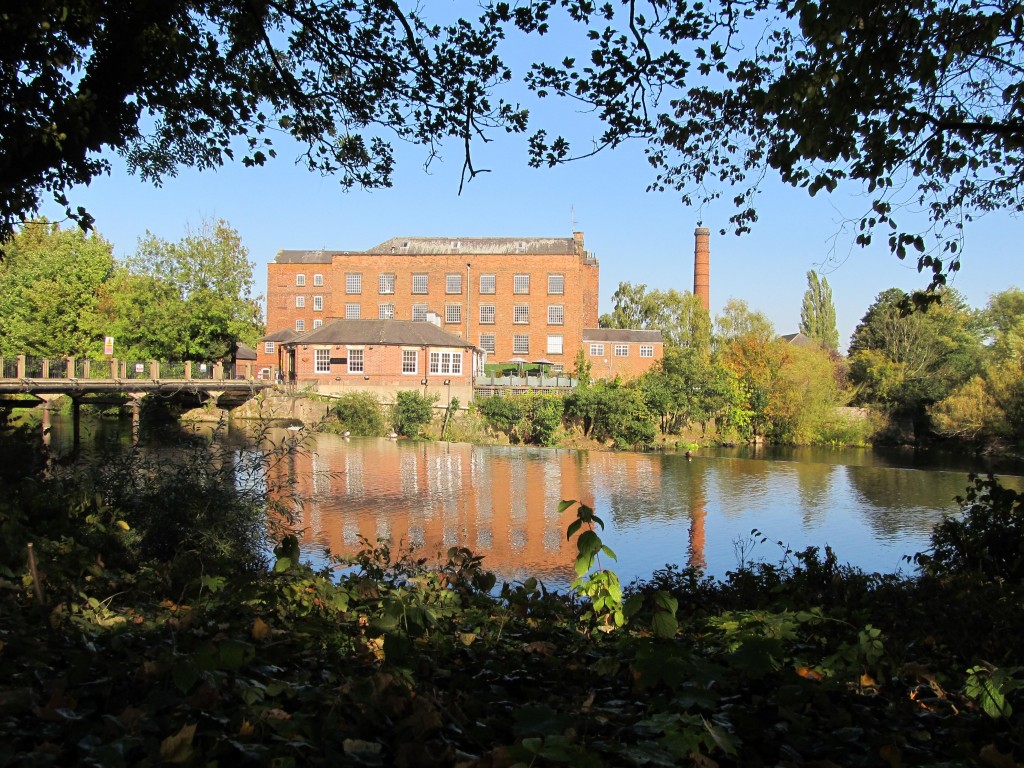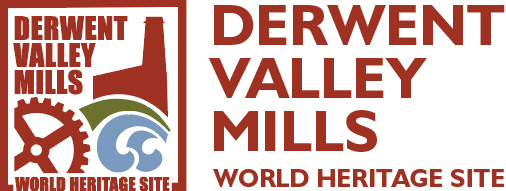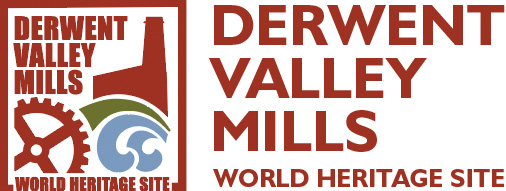Key Sites – Darley Abbey Mills

Key Sites – Darley Abbey Mills
Amassing the estate
The association of the Evans name with Darley Abbey started long before 1782 but the impression is misleading. There were in fact two families bearing the name Evans which were unrelated to one another until 1751 when Thomas Evans, 1723-1814, married Sarah Evans, the daughter of Alderman William Evans of Derby.
Alderman Evans had held industrial interests in Darley Abbey since at least 1746 when he acquired a fulling mill and dye house, but it was not until the 1770s that Thomas Evans and his brother the Reverend Edmund Evans began the purchase of the land holding which was to form the Evans industrial estate. In 1773 Edmund paid Abraham Hirst of Derby £1010-10s-0d for a corn mill, a paper mill, a flint mill and a china mill together with other buildings used by the paper mill; and this together with further purchases made by Thomas Evans in 1774 and 1775, secured for the two brothers all the industrial premises then extant in Darley Abbey.
A partnership with Richard Arkwright
It has to be assumed that this enterprise was planned with the full co-operation of Richard Arkwright, with whom the Evans already worked closely. Indeed, in the early days of the project, it would appear Richard Arkwright and the Evans family were partners. The evidence is contained in the insurance policy Richard Arkwright purchased late in 1782 from the Sun Insurance Company with “William and Edmund Evans for their water cotton mill”. The mill was described as “stone and tiled” and the policy valued it at £800.
The first Darley Abbey Cotton Mill
Little is known of the first Evans mill. A plan drawn by Benjamin Outram in 1792 indicates that the first leat bringing water to the mill was located to the east of the building. In 1788 the mill burnt down. The earliest building which survives is its replacement. There is however good reason to believe that the first structure was much the same as the mill which has survived which is known as Long Mill.
In its first incarnation the mill had a very limited life. There is evidence which suggests it was not ready for production until late in 1786 when Richard Arkwright agreed to lease it from Thomas Evans. The suggestion that the first mill was not ready for production until about this time is further supported by the following advertisement in the Derby Mercury in 1787.
“Darley Abbey cotton mill. WANTED. Families Particularly women and children to work at Said Mill. They may be provided with comfortable houses and every convenience at Darley or Allestry: particularly a milking cow to each family. It is a very good neighbourhood for the men getting work who are not employed in the manufactory”.
The lease with Richard Arkwright was never completed and in 1787 Evans was still buying components from gear cutters and clock makers in Ashbourne and from iron founders to equip the mill with machinery, further evidence of the time it took to fully commission a mill of this size. At the same time he was attempting to find a market for his first production of yarn.
The mill rebuilt and extended
After barely a year the Evans Mill was destroyed by fire. Rebuilding began immediately. The mill had been insured so the Evans escaped total loss. No further set-backs are recorded.
The mill was extended between 1796 and 1805 with a new cut and new buildings and further extended between 1818 and 1821. It also expanded to the north of the original mill site where a number of new processes were installed and ancillary functions such as the counting house and offices and stabling were housed.
The Darley Abbey Mills now employed more than 500 people and growth continued until c.1830. In the later years of the 19th century the business retained and developed further the integration and self sufficiency which in the earliest years had been a necessity. Though ultimately spinning was given up and mule-spun yarn was imported from Lancashire, the company continued all the other manufacturing processes including dyeing and added the manufacture of the bobbins on which the thread was sold and by 1862, the printing of labels and promotional material.
A mature and successful enterprise
A catalogue for the ‘Boar’s Head Cotton Manufactory, Derby’ has survived from September 26, 1855, which lists all Walter Evans & Co’s products. It includes Sewing, Tambour (embroidery), Mending, Knitting Cotton and Haberdashery, and it is clear that in addition to Evans own output, goods were being bought in for resale. In this way the Evans service to their retailers could be made more comprehensive. Such items included sarsnet, a fine soft silk material used for lining dresses; ferrets, a tape of cotton or silk; galloons, ribbons of gold or silver thread used to trim garments; and handkerchiefs, braces, pins, needles, bonnet wire, buttons and whalebone.
The Evans seem to have been first among the Derwent Valley factory masters to develop a retail as well as an industrial or commercial presence and attempt to serve the market which existed in people’s homes for sewing cottons, knitting cottons and embroidery threads and materials.
Evans had agents in London, Manchester, Blackburn, Leicester and Nottingham and travellers who covered other centres such as Birmingham. Their brand name, Boar’s Head, a name suggested by the family coat of arms which included a boar’s head, was in use by the middle of the century. Boar’s Head thread was exported all over the world except to those markets where a porcine image might be culturally offensive. In these cases alternative brand names were used.
In 1862 a visitor noted that Boar’s Head crochet cotton was still being wound by hand and that much of this work was carried out “by the people of Darley in their own homes”. It is likely that this was the last of the outwork. When the mills first opened it would have been extensive. Cotton picking, still at this time an unmechanised process, was dealt with outside the mill and some of it was put into the hands of contractors. As the firm acquired batting and willow machines the demand for pickers grew less. James Huthwaite discovered this in October 1803 when (Evans):
“gave him notice that it was uncertain how long his hands could be employed to pick for Walter Evans & Co and that he must give the worst of his hands a month’s notice on his return home”.
In the 1860s and ‘70s, Boar’s Head products won international recognition: at the London exhibitions of 1861 and 1862; in Dublin in 1865; in Paris in 1867; in Vienna in 1873 and in Paris in 1879.
The end of the line
The Evans involvement in the business ceased with the death of Walter Evans in 1903. John Peacock, who had been manager, bought the mills from his estate. The Peacocks ran the business until 1943, when it was taken over by J & P Coats. In 1969 the sale of the mills for other uses began. The mills are now home to a variety of small businesses.
The first Darley Abbey cotton mill – with illustrations (pdf)
Darley Abbey
The settlement of Darley Abbey lies a little over 2 kilometres north of Derby City Centre. By the 17th century this small settlement had become established as an industrial hamlet near, but quite separate from, Derby. By the middle of the century there were two fulling mills and two corn mills and there may also have been a forge, Shrogg’s forge. By the 1680s the fulling mills had grown to three and 30 years later a paper mill had been added. From c.1750 one of the more distinguished of these industrial tenants was William Duesbury, 1725-1786, the founder of the Derby Porcelain Factory, who had a flint mill here. In the early 1770s there were five separate water-powered mills; a paper mill, a corn mill, two flint mills and a leather mill.
It was to this well established industrial settlement that the Evans family added their cotton mill development in 1782 and subsequently their factory village.
The Boar’s Head Mills
The cotton mill structures which survive in Darley Abbey are among the most complete of any of the early cotton factory sites and, in the context of the Derwent Valley, are comparable with Cromford in the degree to which both the principal and the ancillary buildings remain intact.
A detailed survey of the site is underway and the conclusions recorded here are subject to further evaluation.
Long Mill (1782-89 – Listed Grade I)
The mill in its present form was re-built in 1789 after fire in December 1788 destroyed the earlier building of 1782. It is likely that the existing structure incorporates parts of the shell of the first mill but no detailed examination of the mill which could confirm the extent to which this may be true has been made. The five-storey plus attic mill is 38.4 metres long and 10.1 metres wide externally and has a masonry ground floor with brick above. Many of the exposed wooden structural members inside the mill are protected against fire by metal sheathing. It is not clear whether this is contemporary with the re-building. If it is an original feature of 1789, it is probably the earliest surviving example of fire-proofing in a textile mill.
The roof is framed by wooden queen post trusses with metal cladding and the collars of the trusses are cambered to give a central headroom of over six feet. There are short side walls below the lower rank of purlins and these are also metal-sheeted while the roof slopes above the purlins are plastered on wooden lathes. There is a plaster partition with a panel door dividing off a section of the attic and this may be the Sunday School meeting room referred to in a letter of 1791 from Evans to the Royal Exchange Insurance Company. The attic was reputedly used as a schoolroom and its height and finish would allow such use. A similar use is known to have been made of the Belper North Mill roof space.
The attic floor is supported by a matrix of wooden beams, an arrangement quite different from any of the lower floors. The matrix is formed of transverse members every two bays (the tie-beams of the trusses) with four longitudinal members between and the beams are all clad in sheet metal. The irregularly spaced cast iron columns are secondary and thus this top floor was probably a clear space.
The floor below, in contrast, has a transverse beam each bay with a central rank of cruciform cast iron columns augmented by later round section cast iron columns. It is not clear that these columns are original, and taking into account the date of the reconstruction of the mill it is likely that they were added later. In July 1799 the Griffin Foundry in Chesterfield supplied 23 ‘iron pillars’ but it is not clear which part of the mill these were for.
Among the external features of Long Mill are a number of different window designs. It is known that the structure was first equipped with opening casements which were later mostly replaced by sash windows. On the eastern elevation of the mill a number of wooden multi-paned windows with cast iron opening casements survive and it is likely that these are some of the original windows. Casements were still being purchased in 1793 from the Griffin Foundry in Chesterfield who also supplied iron sashes in 1798. Other iron casements came from Bassetts of Ashbourne.
A plan made by Benjamin Outram for the extension of the Derby Canal to Darley Abbey dated 1792 indicates that the mill was served by a cut from the river which ran to the east of the building. In 1798 work began to develop this cut in a new route through the Shroggs to take water from higher up the river and it is likely that it was in this period, 1796-1801 that the Middle Mill was constructed. Its lowest storey housed two water wheels, one of which is known to have been a flood wheel, that is to say a wheel set at a higher elevation so that it could be used when the river was running above its usual level.
This wheel, built of timber, together with its wheelhouse, cost £791 and was completed in 1797. A second new wheel was constructed in 1804-05.
West Mill and East Mill (1819-21 – Listed Grade I)
It is known that the Evans extended their mill again in 1818 and finally in 1821. It would appear from the mill records that between 1819 and 1821 both the East new mill and the West new mill were under construction. In 1819 alone more than £3,000 was spent on the East Mill and nearly £4,700 on the West Mill. The building works continued into 1821 and a new waterwheel was purchased during the year at a cost of £1,750. It is not clear whether this wheel was for the West Mill or was a further replacement wheel for the Middle Mill to serve the new East Mill.
The West Mill is of particular interest. It is an L-shaped extension projecting from the middle five bays of Long Mill. Like Long Mill it is brick-built with a masonry ground floor but it is a storey lower and a passage leads from the fourth floor of Long Mill through a hip-slope to the roof space of West Mill.
The entire extension is fire-proof with brick jack arches running longitudinally in the link block and transversely in the return, thus maintaining a single alignment of vaulting. The cast iron skewbacks are supported by round cast iron columns three to each of the longitudinal beams in the link and one to each of the transverse beams of the return.
It is not known when the cut which supplied the two wheels housed in the West Mill wheelpits was constructed.
A detailed investigation of the East Mill has yet to be undertaken.
The Boar’s Head Mills north of the road (From 1790 Listed Grade II)
This part of the mill site has not been surveyed but it is clear from documentary and visual evidence that parts of it date from the 1790s and most of the remainder from the early years of the 19th century. A plan of 1846 confirms this impression. The buildings include an office block, managerial housing, stabling (1804-05), warehousing, gassing sheds and a mill which appears to have always derived its power from a steam engine. This structure may at one time have been used in part as a dye house and is thought to have been built in the 1820s.
The Kiosk-Gatehouse (Before 1846 – Listed Grade II)
An octagonal kiosk stands at the entrance to the mill yard. It is similar (though smaller) to the gatehouse which has survived at Stanley Mills near Perth, and which served the same purpose. A gatehouse once stood inside the entrance to the Cromford Mills and also at Wedgwood’s factory at Etruria. Indeed the gatehouse was as much part of the early factory as the factory bell.
In Darley Abbey the gatehouse has for so long served as a tollhouse that it has come to assume that name but its earlier function is clear from its location.
Darley Abbey and The Boars Head Mills – with illustrations (pdf)

